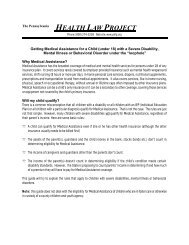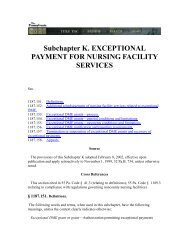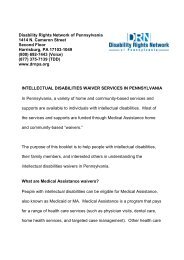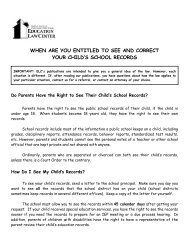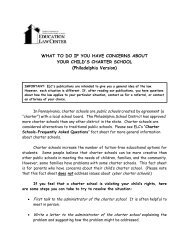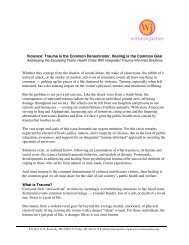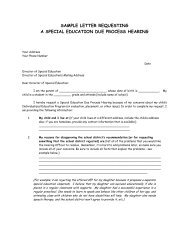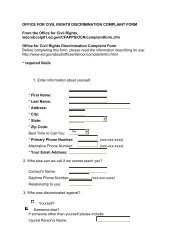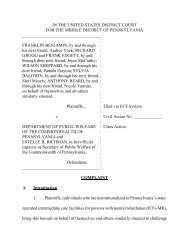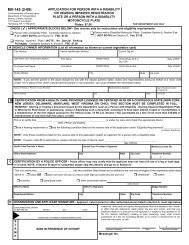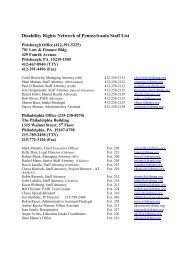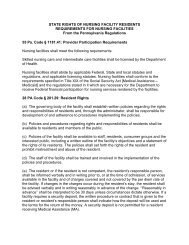POSITIVE BEHAVIOR SUPPORT AND - Disability Rights Network of ...
POSITIVE BEHAVIOR SUPPORT AND - Disability Rights Network of ...
POSITIVE BEHAVIOR SUPPORT AND - Disability Rights Network of ...
Create successful ePaper yourself
Turn your PDF publications into a flip-book with our unique Google optimized e-Paper software.
Making sure that all <strong>of</strong> Pennsylvania’s childrenhave access to quality public schoolsAVOIDING DISCIPLINE PROBLEMS:<strong>POSITIVE</strong> <strong>BEHAVIOR</strong> <strong>SUPPORT</strong> <strong>AND</strong>LIMITATIONS ON THE USE OF RESTRAINTSIMPORTANT: ELC's publications are intended to give you a general idea <strong>of</strong>the law. However, each situation is different. If, after reading ourpublications, you have questions about how the law applies to your particularsituation, contact us for a referral, or contact an attorney <strong>of</strong> your choice.HOW CAN THE IEP TEAM ADDRESS <strong>BEHAVIOR</strong>AL ISSUESMY CHILD IS HAVING?If you think that your child’s behaviors are harming her success at school,you should write to the principal and request an IEP Team meeting. At the IEPmeeting, the Team should discuss the problems the child has at school and suggestchanges that might help stop the behaviors. The IEP Team must ask twoquestions: (1) Do the child’s behaviors hurt the child’s ability to learn? and (2) Dothe child’s behaviors hurt other children’s ability to learn? If the answer is “yes”to either question, you should request that your child receive a “functionalbehavior assessment” (FBA) (an evaluation <strong>of</strong> what things cause the misbehavior).The FBA should be used by the Team to write a Positive Behavior Support Plan(PBSP).A PBSP should include techniques and interventions that are based onresearch and are the least intrusive possible for the child. You should make surethat the PBSP is part <strong>of</strong> your child’s IEP and is based on positive measuresdesigned to help, not punish, your child. The IEP Team should include goals andspecially designed instruction in the child’s IEP that reinforce positive behavior,such as positive verbal statements from school staff. The Team should not include
negative or aversive techniques, which are techniques that make the child have anegative association with the problem behavior.If the behaviors do not improve, the IEP Team may need to meet again tochange the PBSP and other provisions <strong>of</strong> the IEP to address the behavior. The use<strong>of</strong> restraints (discussed in more detail below) to control a child’s behavior may beused only as a last resort and only after other less restrictive measures have beentried.Hopefully, with a Functional Behavior Assessment and an appropriateBehavior Support Plan using positive behavioral techniques, the child’s behavior willimprove. If the school does decide to discipline the child, for example bysuspending, expelling, or transferring the child to another school setting, there arespecial protections that apply to special education children and to some childrenwho may have disabilities that have not yet been identified.Tip: A Functional Behavior Assessment Worksheet can be found athttp://www.pattan.k12.pa.us/files/Behavior/FBA070808.pdf. A sample PositiveBehavior Support Plan can be found athttp://www.pattan.k12.pa.us/files/Behavior/PBSP070808.pdf. If your child ishaving behavior problems in school, you should get copies <strong>of</strong> these documentsand share them with your IEP Team. The Pennsylvania Training and TechnicalAssistance <strong>Network</strong>’s website also has more information about behaviorsupports, including consultants who can help schools do FBAs. Go towww.pattan.k12.pa.us and under “Evidence-Based Practices,” click on “Behavior.”DOES THE LAW LIMIT THE USE OF RESTRAINTS BY SCHOOLS?Yes. The law limits the use <strong>of</strong> restraints by schools to control the behavior<strong>of</strong> children with disabilities. Restraints are the use <strong>of</strong> physical force to stop achild from freely moving. An example <strong>of</strong> a restraint is a teacher holding down achild. If a school employee provides hand-over-hand assistance to a child to eat orholds a child’s hand to cross the road safely, this is not considered a restraint thatis subject to restrictions under the law.2
A school can use restraints to control a child’s serious or frequentaggressive or self-injurious behavior only if:• the child is a clear and present danger to himself or to others, and• other less restrictive methods to control the behavior will not work.If a school does use restraints under these circumstances, it must hold anIEP Team meeting within 10 school days <strong>of</strong> the incident, unless the parent agreesin writing that no meeting is needed. At the meeting, the Team should considerwhether the child needs a functional behavior assessment, a reevaluation, a newpositive behavior support plan, or a change <strong>of</strong> placement.In addition, schools must collect and report information on the use <strong>of</strong>restraints to control aggressive behavior to the Pennsylvania Department <strong>of</strong>Education. The Bureau <strong>of</strong> Special Education has developed a web-based system fortracking the use <strong>of</strong> restraints by schools, and the Bureau must review this datawhenever it regularly monitors a district for its compliance with special educationlaws.For some children, the use <strong>of</strong> restraints may be appropriate as part <strong>of</strong> thechild’s IEP, at least for some time period. The IEP Team may decide to include theuse <strong>of</strong> restraints in a child’s IEP if the restraints are used along with PositiveBehavior Support and the child is taught skills to stop the problem behavior. Staffthat will use the restraints must receive appropriate training. If restraints arepart <strong>of</strong> a child’s IEP, there must be a plan in place to eliminate the need forrestraints in the future. Restraints cannot be part <strong>of</strong> a child’s IEP for theconvenience <strong>of</strong> school staff or as punishment <strong>of</strong> the child.Schools may use mechanical restraints (such as seatbelts and safetyharnesses) to control a child’s involuntary movements, prevent a child from harminghimself, or promote proper body positioning only if use <strong>of</strong> such restraints is:• recommended by a qualified medical pr<strong>of</strong>essional,• included in the child’s IEP, and• agreed to by the parents.3
The use <strong>of</strong> prone restraints, in which a child is held face down on the floor,cannot be used at school under any circumstances.If you believe that a school has used restraints inappropriately or usedrestraints that were not included in your child’s IEP, you should ask for an IEPTeam meeting to discuss the matter. You can also file a complaint with the Bureau<strong>of</strong> Special Education if the school failed to follow any procedures in your child’sIEP about the use <strong>of</strong> restraints. If the misuse or unauthorized use <strong>of</strong> restraintshas injured your child, you may want to consult with a private attorney about howto proceed.Funding for this brochure was provided by:<strong>Disability</strong> <strong>Rights</strong> <strong>Network</strong> <strong>of</strong> Pennsylvania (DRN), pursuant to the DevelopmentallyDisabled Assistance and Bill <strong>of</strong> <strong>Rights</strong> Act, P.L. 101-496, and the P&A for MentallyIll Individuals Act, P.L. 99-319. DRN is located at 1414 N. Cameron Street, Suite C,Harrisburg, PA 17103. Telephone: 800-692-7443 or 717-236-8110. Website:www.drnpa.org.Pennsylvania Interest on Lawyers Trust Account Board (PA IOLTA)Prepared by: Education Law Center (Rev 4/09)(215) 238-6970 (Philadelphia)(412) 258-2120 (Pittsburgh)www.elc-pa.org4




